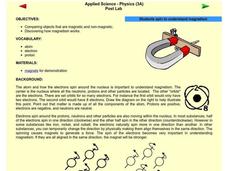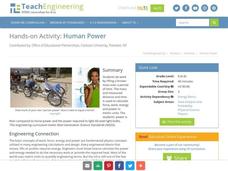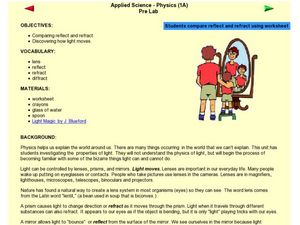Curated OER
Learning About Location: Charting the Path of the George W. Elder
Students acquire a working knowledge of the geographical concepts: absolute location, relative location, longitude and latitude. They analyze primary sources that shows the physical and human characteristics of the places along the 1899...
Curated OER
Dead Body Math
Students solve the mystery of dead Mr. Potato Head using physics and algebra. They discuss Newton's Law of cooling as it applies to the mystery scenario involving a cooling baked potato as the "victim". They manipulate algebraic...
Curated OER
Mixing and Stirring
Students experience mixing through dancing. In this physical science lesson plan, students not only dance to show mixing but also demonstrate mixing and stirring by combining milk and chocolate milk.
Curated OER
Magnetism
Learners study magnetism. In this science lesson, students participate in an activity to discover how electrons in a magnet move. Learners identify items around the classroom that are magnetic.
Curated OER
E3 Project Instructional Plan: Light
Eleventh graders investigate the nature of light. In this physics lesson, 11th graders determine how light intensity varies with the distance of the light source.
Curated OER
Discovering a Law of Space Physics
Students use data collected by an astronomer to determine the relationship between the time it takes the planet to orbit the sun and the average radius of the planet's orbit around the sun. Students use trial and error to find the...
Curated OER
Investigating daylight
students investigate a natural factor affecting their everyday lives: daylight. First, they collect data on sunrise and sunset in their hometown, create a Microsoft Office Excel chart to help them understand the data pattern, and offer a...
Curated OER
Go To Sleep, Gecko!
Students study the characteristics of geckos. They share what they already know about geckos before examining where their natural habitats are and what contributions they make. Also, they look at the physical features of geckos. They...
Curated OER
Infrared Zoo Lesson 2 Index Dinner in the Dark
Students discover how certain snakes can find prey using a natural infrared sensor. They think about small prey animals and how a pit viper snake finds them in the forest. Students explore the physical characteristics of the animals...
Teach Engineering
Gumdrop Atoms
There's nothing sticky about the resource, unless you count the gumdrops! Scholars create a model of a lithium atom, complete with protons, neutrons, and electrons. It's just that these models are made with gumdrops and toothpicks.
Teach Engineering
Bubbles and Biosensors
Bubbles aren't just for children. In the third installment of a seven-part series, teenagers use bubble solution to create bubbles and observe patterns of refraction on the bubble surfaces. Application of this concept to thin films in...
Mathematics Vision Project
Quadratic Functions
Inquiry-based learning and investigations form the basis of a deep understanding of quadratic functions in a very thorough unit plan. Learners develop recursive and closed methods for representing real-life situations,...
Teach Engineering
Human Power
How many humans does it take to power a light bulb? The 10th part of a 25-lesson Energy Systems and Solutions unit has learners conduct an experiment to calculate power. They then use the results to determine how many classmates they...
Teach Engineering
Photosynthesis—Life's Primary Energy Source
Wouldn't it be great if you could produce your own food? Scholars learn about the processes of photosynthesis and cellular respiration in plants. They consider how to use photosynthesis as a model of an efficient system and how to apply...
Curated OER
A Giraffe Debate
Learners study the life, adaptations, and habitats of giraffes. They investigate the issue of giraffe survival in the wild or in a wildlife sanctuary. They conduct a class debate and present position papers.
Curated OER
Fish Haunts
Students examine some of the different ecosystems that fish live in. While doing this they identify the species of fish and the ecological conditions needed for survival. Students use research resources to make fish cards that have...
Curated OER
Environmentally Friendly Home
Students discuss ways to make homes more environmentally friendly. They comprehend ways to reduce home resource consumption, such as passive solar heating, insulation, and geothermal heating and cooling
Curated OER
Chernobyl
High schoolers list some of the health effects of radiation exposure. They are engaged in a unit on nuclear power by demonstrating the potential environmental health risks involved.
Curated OER
Biomedical Imaging
Students use guided questions and research to compare two biomedical imaging methods. they effectively present their findings to the class. Students use new technical knowledge to summarize and compare new techniques with those they...
Curated OER
Reflect and Refract
Students explore light. In this properties of light lesson, students define the terms refract, reflect, and diffract after listening to the teacher's description. Students listen to the book Light Magic and observe a spoon in a glass of...
Curated OER
Spring of Life
Students explore Florida's springs using video segments. In this video instructional activity, students examine Florida's springs ecosystem, the animals that live there and the red tide that threatens the environment. The instructional...
Curated OER
The Structure of the Galaxy
Learners infer the galaxy shape. In this structure of the galaxy lesson students observe the distribution of objects in the sky and answer questions.
Curated OER
Emergency Preparedness
Students take a closer look at emergency preparedness plans. In this writing skills lesson, students evaluate the severe weather, natural disaster, and threat plans in place at their school and then write their own improved emergency...
Curated OER
Magnetic Experiment
Third graders experiment with magnets. In this magnet experiment lesson, 3rd graders explore magnetic attraction and repulsion. Students rotate through four stations and investigate the properties of magnets.

























